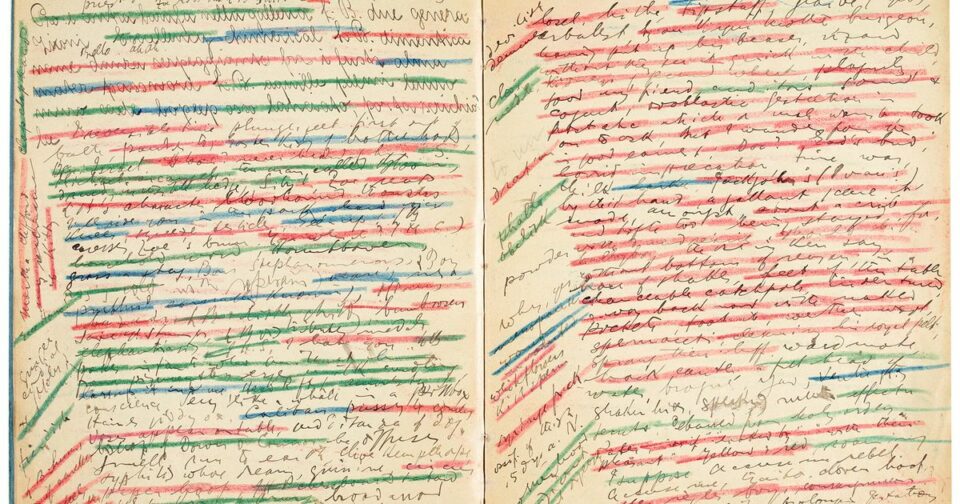
For 40 years, I was an editor, mostly of magazines, including this one. As an editor and as a reader, I found the story of how creators create irresistible. I liked that these stories had a classic structure to them — each inherently dramatic, starting with nothing and ending with something. I assigned a story on Stephen Sondheim in which he explained how he wrote a single song. I traced the evolutions of buildings and novels and soap-opera arcs. Cultural procedurals were especially good material.
When I quit my magazine job, I decided to try my hand as an artist. It wasn’t entirely abrupt: In my work, I always found it satisfying telling stories in photographs and graphics and drawings, and in spare moments — a whim at first — I picked up a paintbrush to try making images myself. When I left my job, I began to paint more seriously. That was the beginning of my torment: I just wasn’t very good.
Decent paintings sometimes emerged, but they seemed almost by accident. And they were accidents I couldn’t necessarily re-create. I was conservative — if one part of a painting showed promise, I would protect it and put the rest of the painting at risk. Sometimes I could get something going and then tentatively feel emboldened to try something new and then fall back, and that would scare me — so I would retreat to what I knew, which meant resuming the bad habits. I got frustrated easily and gave up easily, never knowing when to persevere or surrender. You can see that these are all problems more of the head than of the hand (though there were plenty of technique issues as well). Basically, it all seemed impossible.
When I was at my most exasperated, I found myself asking the same question I had asked as an editor: How does anybody make art? Only now, my professional interest had become personal. The problems I am describing were ones of editorial self-scrutiny run amok, as if I had an overeager immune system that was sabotaging me. Then I came across a monograph about the figurative artist Eric Fischl and this passage, in which he describes the making of one of his more famous paintings, called Bad Boy.
I actually had no idea what I was looking for … I started out just wanting to paint a bowl of fruit. I went from painting that bowl of fruit to constructing the room that the fruit could be in, to finding who might be in that room and what time of day it was. Who I first thought was in the room wasn’t there. People came and went. The twelve-year-old boy stealing money from the purse started out as an infant, lying next to the woman; then became a five-year-old sitting on the edge of the bed … He literally grew up in that room … I just kept following it, [trying] things that didn’t work … I just painted things in, and painted things out.
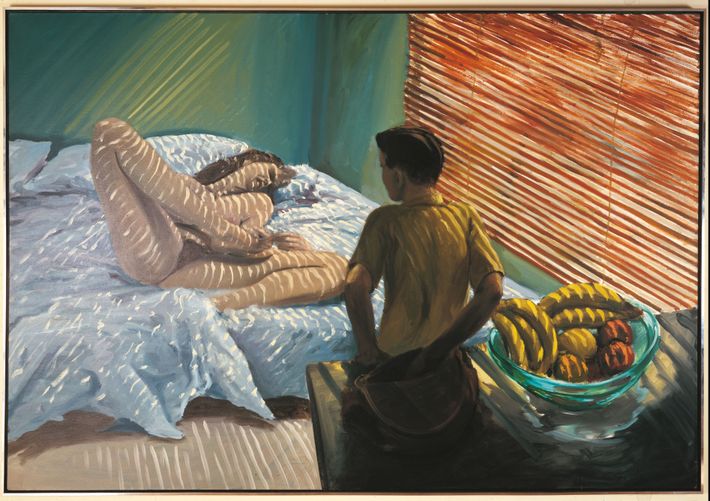
Reading this account, I felt some of my torture starting to lift. I appreciated Fischl’s willingness to allow me into his mind as he stumbled through the work. His struggle was comforting — and illuminating. It gave me the beginnings of an idea. When artists speak, they generally focus on what their work means. They think up a spiel they can repeat over and over, and I guess it’s what most people want to hear. My curiosity is earthbound: Where do they begin, and what do they do next, and when do they know they are finished? And more crucially: What do they do when they lose faith? Do they lose faith?
In other words, how do artists think? As I considered my flailing artistic efforts, I realized I was begging for entrance into the artist’s head. If I could somehow make the process legible, I might find making art myself less intimidating, and maybe what was true for me would also be true for a reader. And so I began talking to creators of every kind about their thinking — step by step, agony by agony — as they made a work. Condensed and adapted, here are three of those conversations with the artists Cheryl Pope and Kara Walker and the poet Louise Glück; the last took place shortly before Glück died in October.
So no meaning, no magic, just the work of it: the work of art.
Realizing she was suddenly doing a lot of planting.
“I took this picture a few days after the third miscarriage,” she said. “I’m in a really messed-up space here. One of my ways of coping, I realized later, was that I started amping up my plant life at home. Like, Yes, I lost these babies, but I can grow things. I was repotting everything.” She took the pictures because she thought that the planting might “be telling me something.”
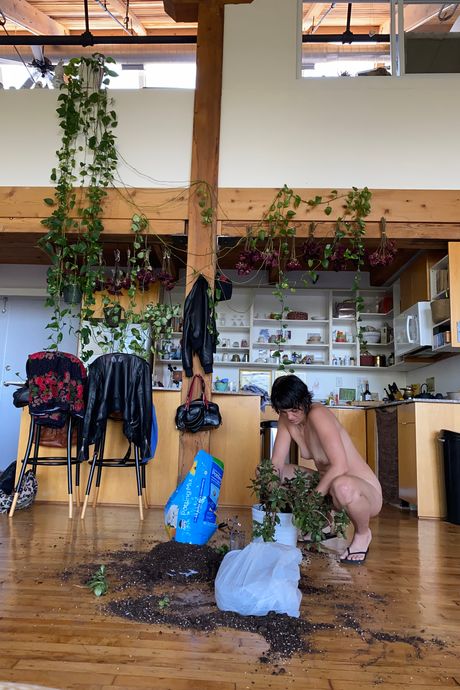
Imagining what she’d lost.
“This was the first one I did, maybe three days after the miscarriage. I’d had an image I’d been working on when I was pregnant of me sitting on the bath. I took it out, and I see she’s sitting on the bath because she’s washing someone; everything was composed for a child to be there. My partner had been very against me drawing any images with the child until I had the child. But once I’d had that third miscarriage, I’d imagined this so many times I wanted to give myself the gift of seeing what I had imagined. What I wanted to happen, what I imagined would happen, what didn’t happen.”
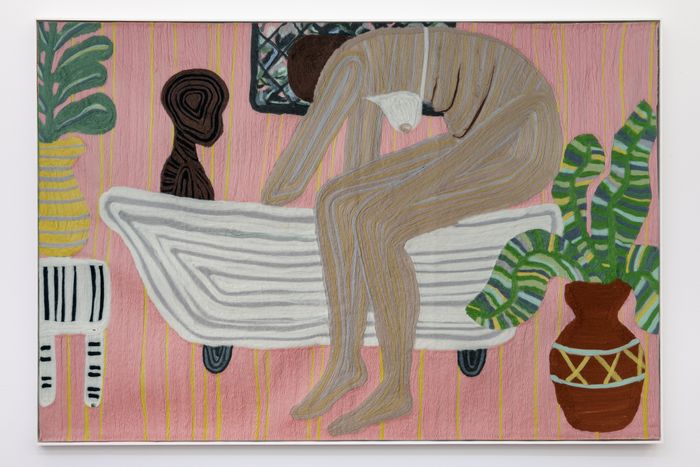
Getting the image right.
“When I went to begin what became Mother and Child on a Blue Mat, I couldn’t find the plant picture in my phone, but I remembered it. So I re-created the scene and took several pictures of it. What I liked about this version was this shape with her leaning down. I’m starting to make an oval.”
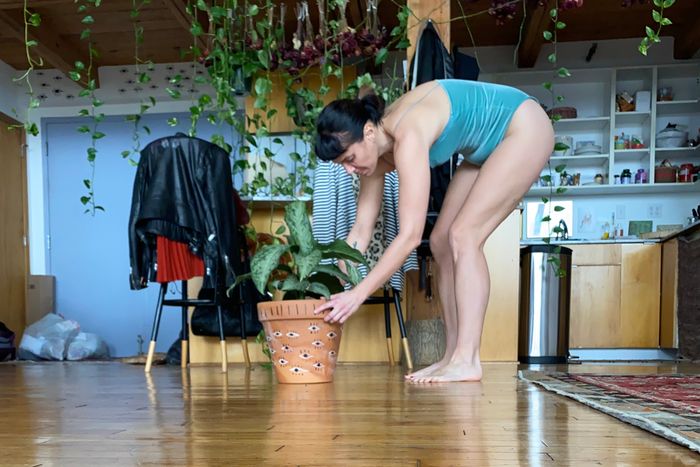
Giving herself permission.
She translated the photo composition to felt and tentatively placed a child in the image, almost as an imagined witness to the mother and the plant. “When I looked at the photo, it was almost like I was talking to this baby that wasn’t there. Where is the child — the child was absent, but was it present in the plant? Do I put the child where the plant was? I’m asking myself these questions, and then I started to do some research. I realized that Mary Cassatt, who is the go-to painter for mothers and children — she also didn’t have any children herself. She gave me the freedom to say, ‘I can do this.’ Those miscarriages were my motherhood. So I made this drawing. I love composition, composition makes any work work — the psychology, the feeling of a work for me, is in the composition. I was interested in this circle and this larger circle.And I started to get this anxiety, like, Why is she picking up the plant? I want to pick up the baby.”
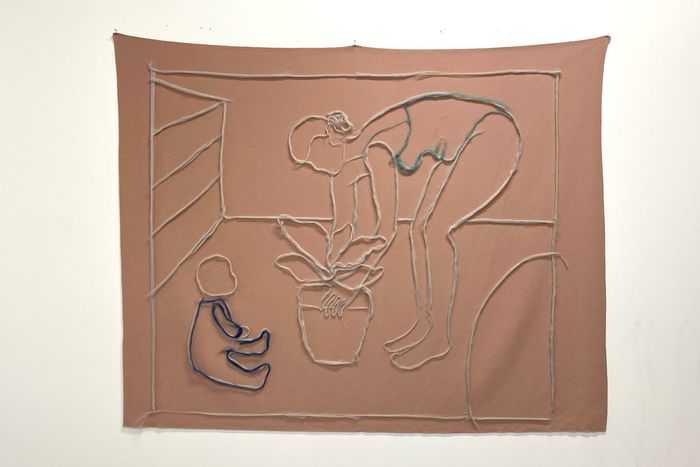
Moving the baby.
“And I was going to leave it like that, but I had a call with a friend who also had a miscarriage. While I’m talking to her, I’m looking at the image. And I got off the phone and I just moved the baby over: Let me just draw him over here. But I didn’t want to surrender the other drawing yet. This may be TMI, but I draw when I’m ovulating because I’m the most sensual. So my time window matters with these. And I record the image because I think I really like this, too. I like this echo, I like this as a misplace.”
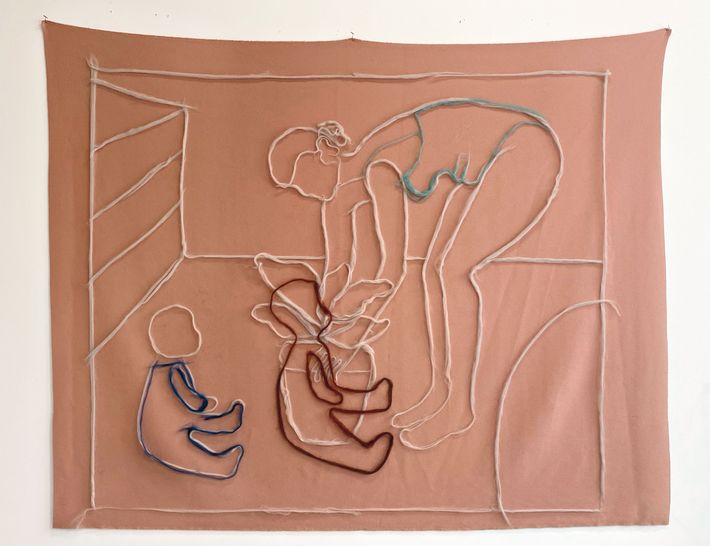
She plays with the introduction of an illogic to the work by including a baby and its phantom, but eventually she decides to just have one baby in the image. The plant and the baby switch places: “They still make this nice circle.” The circle is important because she sees the three miscarriages as a cycle. “That’s why the composition is circular. I’m circling around this, I can’t get out of it.” The tenuous embrace between the mother and the child was also important to her. “In the same way that with mothers, there’s this ongoing relationship of the child disconnecting from the mother, I’m also thinking about connection and disconnection between the real and the imagined in my own situation with the child. This child did disconnect from me already.”
Filling it in.
“Color has to start to work with composition; it controls the way I move my eye. Someone asked Kerry James Marshall once, “Why did you make that rug a pattern?” I think his answer was that otherwise it would be boring. Pattern keeps the eye irritated, active. So we stay engaged longer. I’m not following color theory; it’s just intuition.” She wrestled with decisions: “Should I leave the floor white? Do I want to leave her hair like this?” And especially: “How much do I keep telling and not telling in this image?”
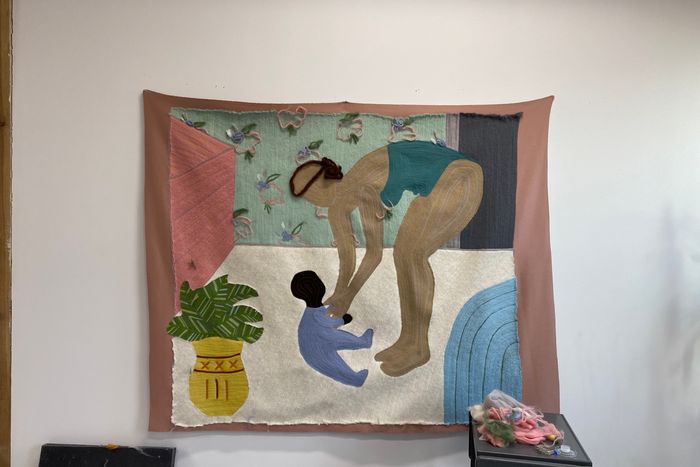
Of particular worry was the skin color of the child. Her former partner, the baby’s father, is Black. She is white. “My anxiety is hyped up because I am worried about how people are going to read race in the picture.” She tried to put a softer brown rather than black to make him look mixed race, but it doesn’t work. “I’m well aware that a child is born lighter and can get darker,” she said. But she is worried that because she’s white, viewers will think she doesn’t know this. “I have to tell everything in this one image,” she said. “There’s no room for nuance in this political climate. And that’s suffocating.”
Deciding on a face.
Of all the decisions she had to make for this work, the hardest might have been the decision to give faces to the mother and baby, or not — to make the picture specific or to generalize, to close it, in her words, or to open it. “Finally,” she said, after much deliberation, “I go all the way.” She gave both the mother and the child a face.
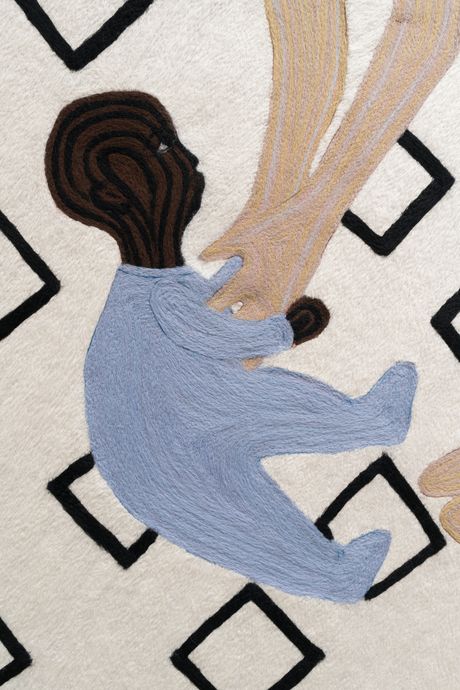
Even after she was done, she had regrets about having included the baby’s face: “Later, when I looked at the piece, I went back to the gallery to take it down because it just tells everything. Everything is told here. But it was too late. Because then it became public.”
“If you were to do the picture again, you’d do it without facial features on the child?” I asked her. “One hundred percent,” she said.
Dreaming up Leo.
Adam Moss: How did this poem begin for you?
Louise Glück: There’s that piece of paper in the notebook that says, “Leo Cruz has white bowls, I think I must get some to you.” Those lines appeared to me in a dream. I remember waking up and writing them down and thinking, This is a gold mine. If you recited it to someone, they’d say, “What?” There’s nothing distinguished about this sentence. But to me, it was one of the most beautiful lines I’d ever written in my life. And of course it was altered in the final version. But I had a sense when I woke up that day that I had something on the line — some very large fish was toying with me under the water.
AM: Do you know why?
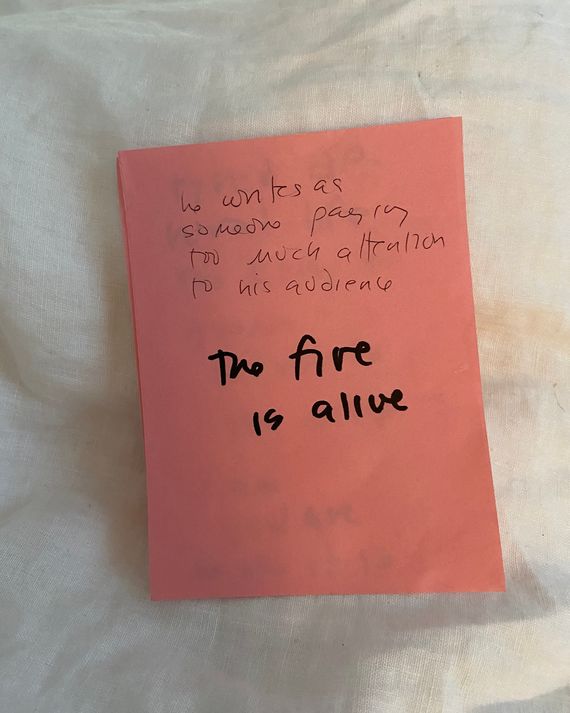
LG: I think that it was partly the proper name. I know no one by that name. Nobody knows who Leo Cruz is. And if no one knows who he is, no one knows where to find him. So there was that sense of something — or someone — who exists, but you can’t get to him. And obviously this is a poem written during COVID with all the terror and longing of that time. But I didn’t want to write a poem that was explicit; I wanted more of a parable. And I saw something in those two lines about what the last year and a half has been. The poem developed from them. There were a lot of false leads. But you write them all down because you don’t know what will, despite its present clumsiness, actually be the most important element of the poem. So that’s how it began. And early on I got the last line. It had to do with the kiln — the fire’s still alive. I was very excited about that line, too. So then I had two pieces.
Gathering fragments.
AM: So you had the first line and you had the last line. Did you start taking practical steps toward turning them into a poem?
LG: I don’t do it like that. I have to have a lot of points in the narrative line before I can sit down and try to play out the progression. And even then, once I have a draft, that sequence might change. But at the very beginning, when I have only a fragment of language or even two pieces that seem related, I just, in a sense, ignore them. But the ignoring allows for a kind of haunting. And so I was haunted by them in that period. Because I couldn’t go to the gym and I was taking long walks every day. So strange, Jesus, what a year …
I would take my walks and I would almost hum the poem in my head. I had worked out a different version for the opening line. I tried writing in my head elaborations of the bowls, what they looked like, but that was just talking. When you do that, you’re sort of waiting to write a good line, and then you can actually erase all the intervening lines. You’re looking for momentum.
Somewhere along the line, I wrote, “never again, that is what we do not say,” and it was pivotal. The “never again” absolute is balanced by “that is what we do not say.” The idea of “never again” hovers in the air, but the refusal to say it is an unwillingness to capitulate to the absolute. As long as life continues anywhere, life continues.
Curing it of “God.”
AM: It seems to me, looking at the notebook pages, that one of the things you were working out is how explicit to be at the point where Leo Cruz explains the purpose of imagination. In the notes, there’s a line “because intention is more moving than effortless splendor.”

LG: Oh God, that’s pretty bad. That became “the things man makes / are more beautiful / than what exists in nature.”
AM: Earlier it was “the things God makes.” You substituted nature for God at some point.
LG: The rhythm of the sentence remained. But initially the sweeping statement (once it was cured of God) was the poem’s pronouncement. “Leo thinks” was added later. This change showed me how to do the poem as a back-and-forth. Someone is wandering across the desert with a book of grasses, and Leo is somewhere making white bowls. And somehow there is a conversation between them that’s either remembered or invented because it is obviously not occurring within the space of the poem. I liked that the future exists in the poem — we make plans to walk the hills together, or whatever I ended up saying. That was the last bit I figured out. I had a lot of really bad plans. And I had the whole poem. But I had that clunker in the middle.
AM: But you knew its function in the poem, right?
LG: I knew that in order to do the “never again,” there had to be a plan. At some point it was “I make plans,” or “I plan,” or “I tell him I’m going to …” These were all variants. And then on your long walk — the same walk every day like a prisoner — you repeat these phrases, and sooner or later they get fixed. But you don’t feel as though you fixed them; something in your head fixes them. And when you get the thing right, you begin to see the shape emerge. And the more the shape emerges, the faster you can work. This poem was written pretty rapidly but for that recalcitrant stanza.
Finding hopefulness.
AM: These pages that we’re looking at, when you take these walks, do you come back to your house and just scribble?
LG: Sometimes I write things down on the walks. It’s important to me not to carry a notebook. If you carry a notebook, the walk becomes too purposeful. I take this magical thinking very seriously.
I was taken out of high school in my senior year because I was acutely anorexic. When I stopped starving myself, I started exercising; I walked all day, literally, every day. I’d stop in at the bakery and borrow a pen and piece of paper. Well, I kept the paper. Because carrying supplies seemed to me dangerous. A jinx. Now I carry a pen. But no notebook. If I write something down, I write on a receipt. When I was 18, I could count on remembering. Now I need backup. But I still believe the really good lines will return when they are part of something. There’s something in your head that doesn’t forget.
AM: Weeds out the bad and selects the good.
LG: Well, we like to think so.
AM: That’s a very hopeful idea itself.
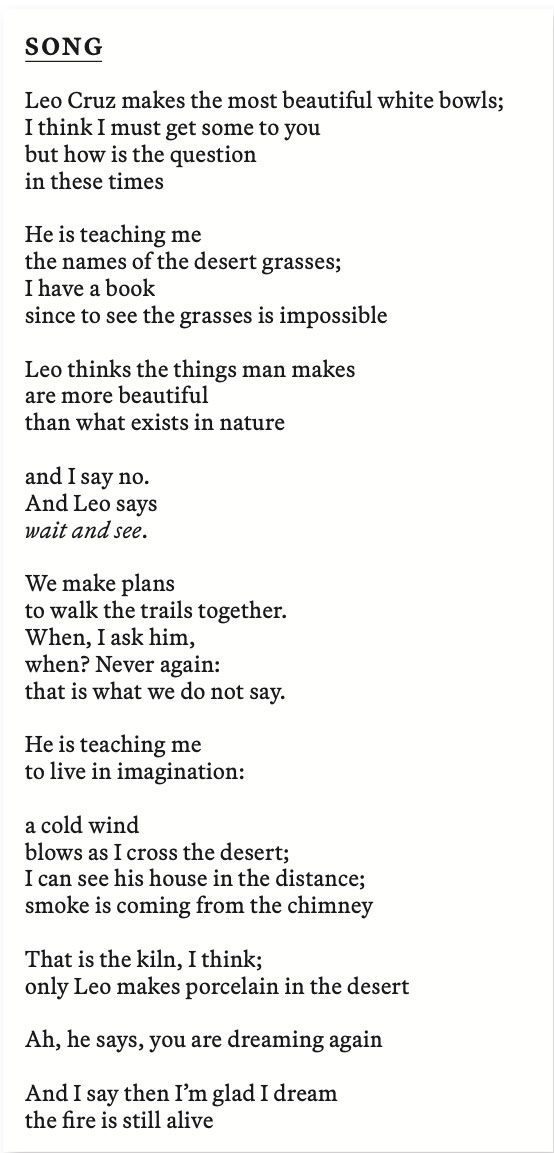
LG: Well, I’m actually very hopeful. I know most of the people who read my poems think I’m not. I mean, I have a very tragic vision of human life, but I’m very optimistic in the short term. And I like to have a good time. No one would believe this. But it’s true.
Most people who have talked about this book talk about its gloom, its grimness. But that to me is not what it is at all. It’s a survival manual: The fire is still alive. It isn’t about survival as in trudging up a slow incline hopelessly. It’s about survival as a kind of triumph, which is how I see it.
Despite everything in the dream, the fire is still alive. The belief in the fire survives all of these impossibilities: You can’t see Leo Cruz again, you can’t have white bowls, you can’t see the desert grasses. But you have a book and can live in imagination. And that’s not nothing.
Casting about.
Creative Time didn’t say anything about what they were looking for. So I had a sketchbook, and I kept asking myself, What about this, or this, or this? I was overwhelmed. For a couple of those months, I couldn’t figure out how to begin. I’d see something on TV and be like, What about that? For a while, I was thinking of some kind of conveyor, one material transforming into another material. And chickens. I don’t know why. And then I also was thinking about waste products, the effect of the sugar on the Domino plant, the heavy molasses smell. And about oil and other by-products and the overreliance we have on things that are bad for us. And then finally I said to myself, You, who are you, Kara? Stop sketching stuff. The deadline for my idea was fast approaching.
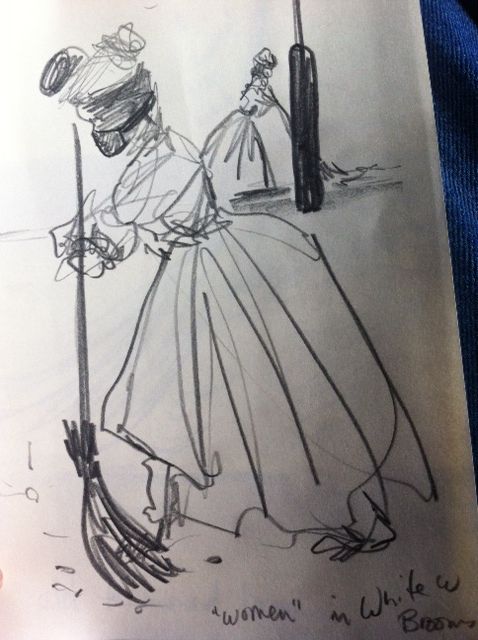
Making a PowerPoint.
So I put together this PowerPoint, which confused everybody at Creative Time. But the PowerPoint was the only sketch I approved of. I couldn’t trust my hand to draw the thing I was trying to articulate because it just wants to make things cute.
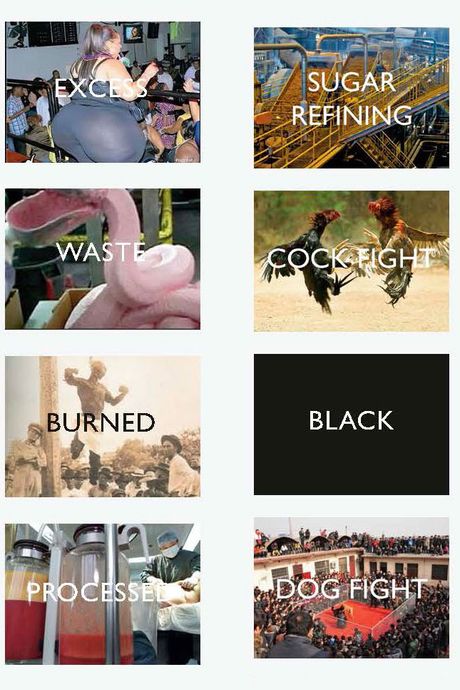
The PowerPoint was a way of synthesizing material, but it also has a rhythm and a poetry to it. I was gathering images that included the chickens but then went into voodoo and rum and sugar and the transatlantic slave trade. I started to read about the process of sugar refining and that it’s not a given that sugar should exist in the world. I started to think about my role as an artist in relation to doing a big public-art project. I got interested in men like the sugar magnate Henry Osborne Havemeyer. Those are the gods of industry. That’s really what I have to imagine myself to be.
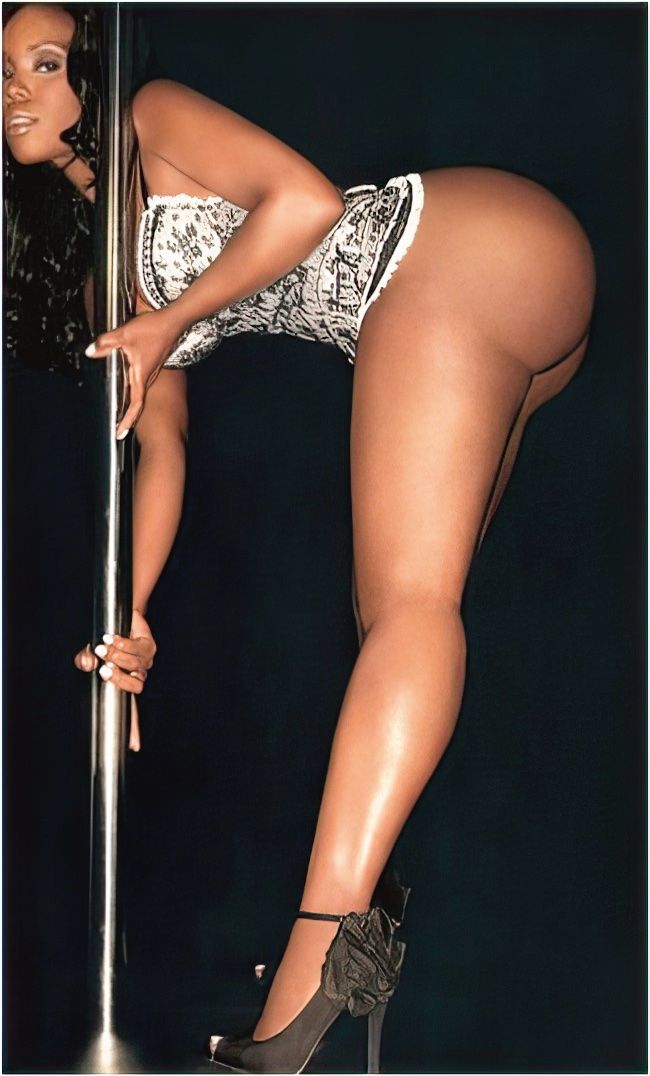
The last piece of the PowerPoint started with sugar and brown sugar, and then I added a pole dancer. And it sort of ends with ruins — a sugar-refinery explosion in Savannah that was entirely caused by sugar crystals in the air. What to do with ruins? We romanticize them. We celebrate them. We go on vacation in them. We make them a public sort of entertainment.
Finding Sidney Mintz.
The one thing that really changed everything was Sidney Mintz’s book on the history of sugar. The sexuality of sugar was already in my head. Plus the liquid stickiness of it just seemed really potent as a sexual symbol. But the Mintz book put the exclamation point on the fact that sugar has been about desire ever since it was refined. Before sugar, you got sweetness from fruit or honey. The sugar high is a real high, like gold, like a spice worth its weight in gold. So only the powerful had access to it. And the quest for that particular sweetness, it generated my history, it generated the transatlantic slave trade.
Becoming the distiller.
And so the PowerPoint is what I gave Creative Time. I said, “I think I’m getting closer.” And they were like, “What is it, exactly? Is it going to be a slideshow?” And I said, “No, no, this isn’t the piece!”
I don’t know how to explain the magic process — maybe it’s not magic but something that switches. I thought, You know, Kara, you’re an artist. You’re kind of a distiller yourself. You have to take all of this information, those impulses, and make some sort of icon, and it has to be something you have no choice about. The time for playing is over. And I’m feeling now I know what the material is. I feel the material. It’s not just an intellectual pursuit. It lives in my body.
Seeing the Sphinx.
I was on the Q train reading the Sidney Mintz book. And there’s a section where he talks about the “subtleties” — these special decorative sugar ornaments for kings, for the celebration of weddings … And you know, we’re so used to sugar we don’t even realize how special sugar is … And I was just like, Oh, it’s a sugar sculpture! And I realized the Sphinx was the perfect sort of ruin. And that was the big moment. From that point on, the drawings are drawn with molasses, stuck together.
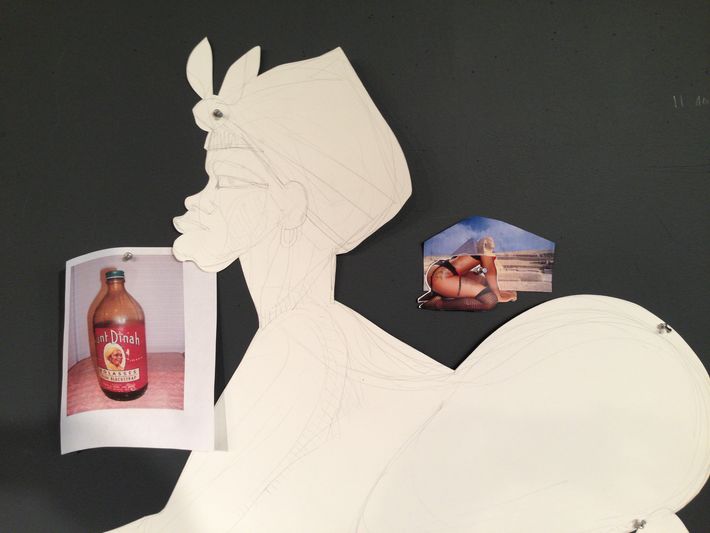
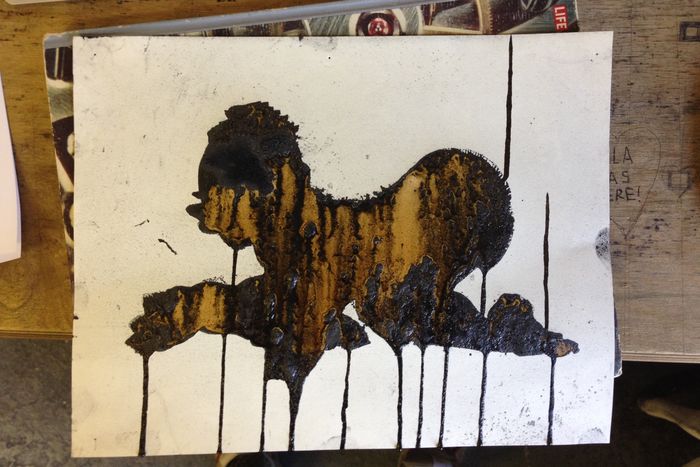
And I thought, It can’t just be a Sphinx, because then it only reads on that one note. We have to open it up to all these other sorts of desires that sugar exploits and represents. And our covetousness for sugar is not unlike sexualized covetousness. So it had to be a female, larger-than-life queen figure with everything open and bare and bare-breasted.
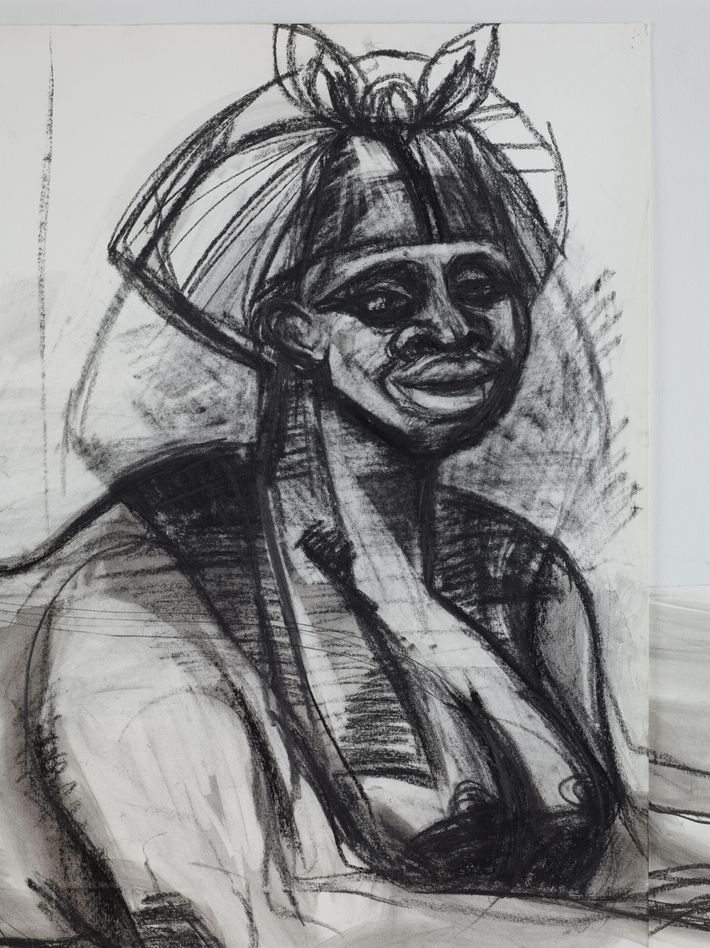
Becoming a sculptor.
The Sphinx was going to be the main sculpture. And so now I had to build a sculpture, and that was terrible. The first iteration at my studio, I was so embarrassed. I don’t know how to do sculpture. So let me just make a table-size one of papier-mâché. And the first one collapsed. That kind of thing can be a big setback. I felt, I don’t know how to do anything. Who do you think you are? So then I made a smaller little clay Sphinx figure. And I took a little snapshot with the refinery behind it. And I had a model of the space, like a little foam-core model. Creative Time helped me facilitate how it could get made; I just knew it should be an object, monumental, something grand.

Finding the sugar boys.
I started looking stuff up, and I found these little “sugar boys” sculptures online — candy dishes. And I thought, These are appalling. I don’t know how I found those boys. My studio was in the Garment District for so long, so I always happened to pass by shops that had tchotchkes in the window, like African-queen kind of figurines. And I thought, These are kind of strange; why are these being made? Who buys them — besides me, apparently? And then I thought these boys could be attendant figures.
Working with sugar.
I wanted them made as candy sculptures, made of sugar. I’m thinking everything is going to be made of sugar. And basically it became, What is possible, what is not possible? What is achievable in the time frame? What is achievable financially? In physics? At a certain point, everything was achievable. We just had to say what it was. So it was this giant sugar sculpture and these candy figurines at a human scale. I didn’t ever have the specific notion that it would melt. That just sort of came with it. I knew it would be an unstable object. But we didn’t really know how unstable until we started making them.
It was all trial and error because nobody had ever done it. People had made smaller sugar sculptures, and there were people in the candy business, of course, and bakers. But when we started asking around for how to do this, they said, “It’s not going to work.” The first one, when we made the molds — well, let me first explain that it’s easy to make candy; it’s sugar and water and temperature. It just has to reach the hard ball stage, when you can pour it into the mold and let it sit. But for us, the molds were so big and the temperature was so hot it never cooled in the interior. So the first one, we took it out of the mold, and at about six o’clock that evening it was a puddle.
Compromising.
Eventually, we thought maybe we have to do some of these in resin, some in resin and some in candy. Okay, compromise. Don’t love it, but maybe it will create the effect. So we made as many of these sugar boys as we could. And then the day before the opening, a truck backed into one of them, maybe two of them got knocked over. Oh my God, that was bad. I don’t know if you remember, but some of the figures have figures inside their baskets. I just picked up the broken pieces of the ones that had fallen and put them in the baskets of the ones who were standing.
Making it hers.
The building process, when that actually started, that was amazing. I’d have fits of giggles because I just couldn’t believe we were doing this. Just stepping into the space … I don’t know how to describe it really. It was intimidating. It was, Is this mine? I had to go back in there and figure out how to make it mine. There were some things I literally couldn’t do. I wasn’t really capable of moving giant blocks of polystyrene. So I would go over there regularly and talk with the team that was shaping everything. It wasn’t until the last phase of it, the last four weeks, that I felt I was really doing something.
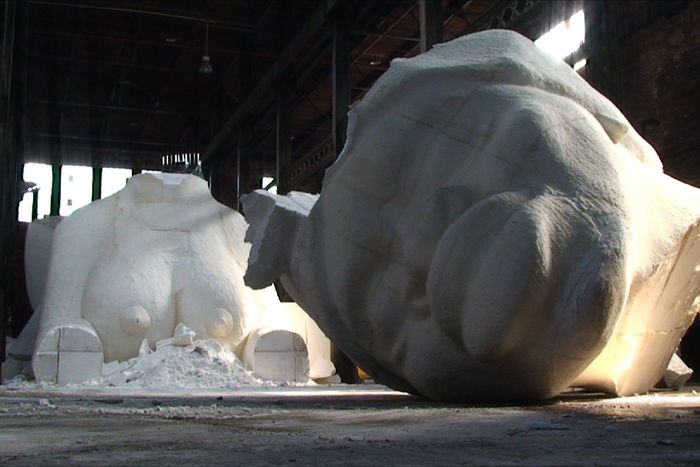
Watching the response.
On May 10, it opened. My daughter went to see it a couple of days before. And there’s a picture of her when she first gets into the space, laughing, which resonated for me because it reminded me so much of my first experience when I presented the work. There was the not seeing of it. People walked into the factory, and they were like, “Wow, wow, wow, look at all the sugar boys.” And then suddenly it was there. And they didn’t know there would be a big thing there. They were just like, “Oh my God.” And I found that very satisfying. So my teenage daughter walked in there and I sort of pointed to it. We were standing in front of it, just looking. You walk around the sculpture, and it keeps changing shape and meaning in the viewer’s eye and mind — I mean hopefully. And maybe it sort of elicits some of those harder feelings that I was thinking about as I was making it — I hope so. I was trying to materialize and manifest the feeling of the histories I wanted to talk about. I had ingested that. I had done something that affected me, and I knew what it was. I knew the effect I wanted it to have. And that was it.
I don’t know about anything, really. I always feel like I’m a novice and I’m just starting out, and even if I have to make work similar to work I’ve already made, cut paper or something, it’s a lot like starting from zero.
Adapted from The Work of Art: How Something Comes From Nothing (Penguin), out April 16.
By Adam Moss , 2024-04-04 11:00:38
Source link
